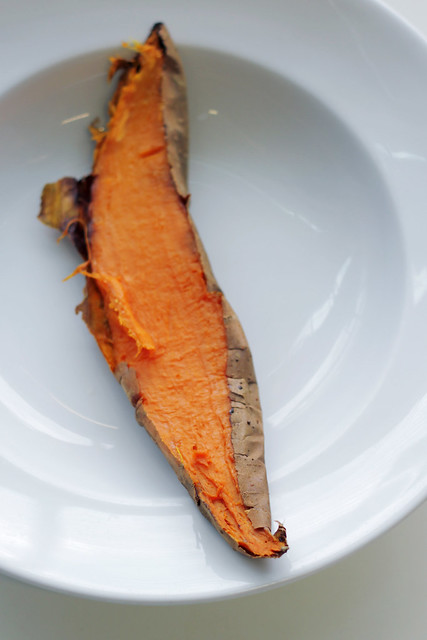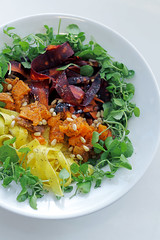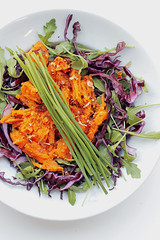Ingredients: Sweet Potato

Sweet potato is a large, starchy, sweet-tasting, tuberous root.
The young leaves and shoots are sometimes eaten as greens. Sweet potato is only distantly related to the potato. Although the softer, orange variety is often called a yam in parts of North America, the sweet potato is botanically very distinct from the other vegetable called a yam, which is native to Africa and Asia.
The edible tuberous root is long and tapered, with a smooth skin whose color ranges between purple, red, brown, and beige. Its flesh ranges from beige through yellow, orange, and purple.
Orange-fleshed sweet potatoes may be one of nature's unsurpassed sources of beta-carotene. Several recent studies have shown the superior ability of sweet potatoes to raise our blood levels of vitamin A. This benefit may be particularly true for children. Sweet potatoes are not always orange-fleshed on the inside but can also be a spectacular purple color.
It's important to have some fat in your sweet potato-containing meals if you want to enjoy the full beta-carotene benefits of this root vegetable. Recent research has shown that a minimum of 3-5 grams of fat per meal significantly increases our uptake of beta-carotene from sweet potatoes. Of course, this minimal amount of fat can be very easy to include.
Besides beta carotene, sweet potatoes are rich in complex carbohydrates, dietary fiber, simple starches, vitamin C, and vitamin B6.
I love it baked or steamed, it's actually very different from potatoes, it taste more like a squash or a pumpkin.
Recipes with Sweet Potatoes:





Sources: wikipedia and whfoods
-----------------------------
Ingredienti: La patata dolce
La patata dolce è una grande radice tuberosa amidacea, dal sapore dolce.
Si possono mangiare anche le foglie giovani e germogli apparentemente.
la patata dolce è solo lontana parente della patata. Anche se più morbida, la varietà arancione viene spesso chiamata yam in alcune parti del Nord America, ma patata dolce è botanicamente molto distinta dal yam, che è originario dell'Africa e dell'Asia.
La radice tuberosa commestibile è lunga e affusolata, con una pelle liscia il cui colore varia tra il viola, rosso, marrone e beige. La sua polpa varia dal beige al giallo, arancione e viola.
La patate dolce a polpa arancione può essere una fonte insuperabile di beta-carotene. Diversi studi recenti hanno dimostrato la superiore capacità di patate dolci per aumentare i nostri livelli ematici di vitamina A. Questa prestazione può essere particolarmente vero per i bambini.
E 'importante avere un po' di grassi nelle ricette conteneti la patata dolce, se si vuole godere il pieno dei vantaggi del beta-carotene. Recenti ricerche hanno dimostrato che un minimo di 3-5 grammi di grassi per pasto aumenta significativamente la nostra assunzione di beta-carotene da patate dolci. Naturalmente, non credo avrete problemi ad aggiungere un po' d'olio extra vergine alla vostra ricetta, crudo ancora meglio.
Oltre il beta-carotene, le patate dolci sono ricche di carboidrati complessi, fibre, amidi semplici, vitamina C e vitamina B6.
Mi piacie moltissimo al forno o al vapore, proprio perche' e' molto diversa dalle patate. Diventa molto morbida alla cottura e il gusto e' più simile a quello di una zucca.
Ricette con Patate dolci:





Fonti: wikipedia and whfoods
I adore sweet potatoes. They are one of the most nutrient-dense veggies around and to discover that they need a good dose of fat to maximise that is just music to my ears (if not my hips!).
ReplyDelete